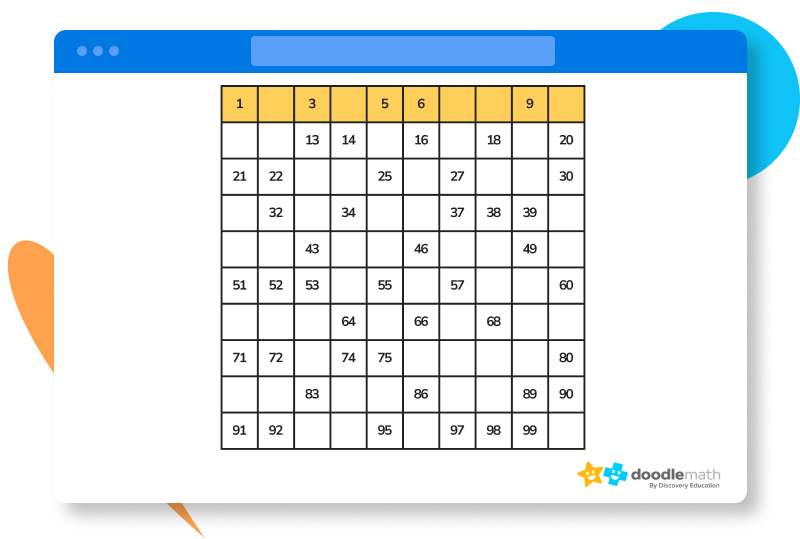


Author
Katie Wickliff
Published
January 22, 2024


Author
Katie Wickliff
Published
Jan 22, 2024



Author
Katie Wickliff
Published
January 22, 2024


Key takeaways
Understanding the sequential order of numbers is a skill that students need to develop before moving on to more complex concepts, so learning to count to 100 is a huge accomplishment for a child.
Want to help your student master the numbers 1 to 100? Introduce a hundred chart. This useful mathematical tool is a great way to develop counting skills.

Unlock unlimited maths questions
Put your learning into practice with fun exercises + games that are proven to boost ability!
At first, students may find counting to 100 challenging or overwhelming. However, several methods will help them master this foundational maths skill. Here are a few tips to help your child learn to count the numbers 1 to 100:

DoodleMaths is an award-winning app that’s filled with thousands of questions and games exploring multiplication, division and more!
Designed by teachers, it creates each child a unique work programme tailored to their needs, doubling their progression with just 10 minutes of use a day. Try it for free!

A hundred chart is a 10×10 grid that displays the numbers 1 to 100 from smallest to largest. Using a hundred chart is a helpful tool that can make counting to 100 more manageable for students.

A 1-100 chart is very helpful for your child to see the numbers in order since many students get “stuck” when transitioning to the next group of ten. Using a hundred chart allows the student to see what group of ten comes next in the sequence.
When introducing a hundred chart, it’s important to help your student notice the following:
This visual introduction to the hundred chart will help your student understand that the chart is a tool to help them count to 100.
Free Downloadable Hundred Chart
Download and print our helpful Hundred Chart to use with your student during counting practice. Then, head over to DoodleLearning’s maths app for even more hundred chart practice.
Now that we’ve learned about number lines, it’s time to practise. Complete the exercises below or head over to our maths app to build more confidence in using number lines.
Place your finger on the purple number 10. Then, move your finger down the page and count aloud by 10s until you reach 100.

Using the hundreds chart above, place your finger on the number 2. Now, find the number that is ten more than 2.
Using the hundreds chart above, place your finger on the number 20. Now, find the number that is five less than 20.
Using the hundred chart below, fill in the missing numbers in the first row.

Using the hundred chart, fill in the missing numbers in the second row.

Help your child see that moving down a row is adding ten.
2+10=12
20-5= 15
The missing numbers are 2, 4, 7, 8, 10
The missing numbers are 11, 12, 15, 17, 19
A hundred chart is a number grid with 10 rows and 10 columns, displaying the numbers 1 to 100 in order.
You read a hundred chart starting with the number 1 in the upper left-hand corner, then reading each row from left to right until you reach the number 100 in the bottom right-hand corner.
There are several differences between a number line and a hundred chart, but one main difference is that a number line can be used to represent any type of number (such as fractions, decimals, or negative integers) while a hundred chart represents whole numbers from 1-100.
There are 101 whole numbers from 0 to 100.
The prime numbers 1 to 100 are: 2, 3, 5, 7, 11, 13, 17, 19, 23, 29, 31, 37, 41, 43, 47, 53, 59, 61, 67, 71, 73, 79, 83, 89, 97.


Parents, sign up for a DoodleMaths subscription and see your child become a maths wizard!

Lesson credits

Katie Wickliff
Katie holds a master’s degree in Education and a bachelor’s degree in both Journalism and English. She has over 15 years of experience as a teacher and is also a certified tutor. Most importantly, Katie is the mother of an 8 and 11-year-old. She's passionate about education and firmly believes that the right tools and support can help every child reach their full potential.

Katie Wickliff
Katie holds a master’s degree in Education and a bachelor’s degree in both Journalism and English. She has over 15 years of experience as a teacher and is also a certified tutor. Most importantly, Katie is the mother of an 8 and 11-year-old. She's passionate about education and firmly believes that the right tools and support can help every child reach their full potential.
Book a chat with our team
If you’d like to use Doodle’s browser version, please visit this page on a desktop.
To log in to Doodle on this device, you can do so through our apps. You can find out how to download them here: